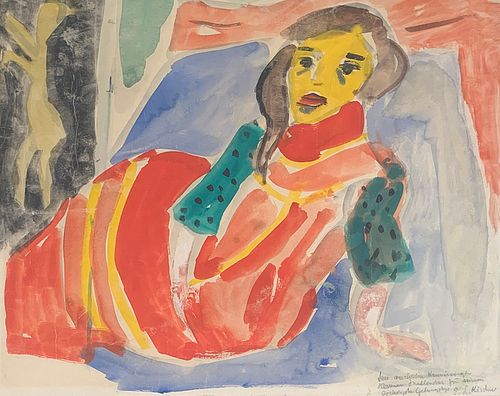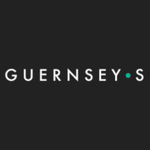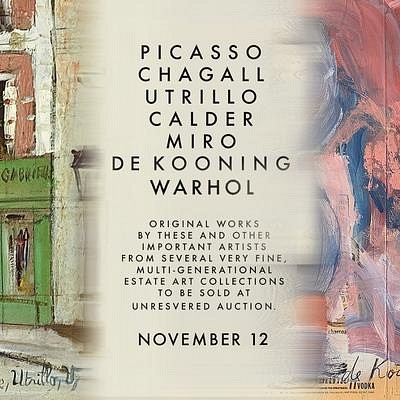E.L. Kirchner Signed & Inscribed Gouache with Watercolor
Lot 98
Categories
Estimate:
$30,000 - $40,000
Absentee vs Live bid
Two ways to bid:
- Leave a max absentee bid and the platform will bid on your behalf up to your maximum bid during the live auction.
- Bid live during the auction and your bids will be submitted real-time to the auctioneer.
Bid Increments
| Price | Bid Increment |
|---|---|
| $0 | $25 |
| $300 | $50 |
| $1,000 | $100 |
| $2,000 | $250 |
| $5,000 | $500 |
| $10,000 | $1,000 |
| $20,000 | $2,000 |
| $50,000 | $5,000 |
| $100,000 | $10,000 |
| $200,000 | $25,000 |
| $500,000 | $50,000 |
| $1,000,000 | $100,000 |
About Auction
By Guernsey's
Nov 12, 2022
Set Reminder
2022-11-12 14:00:00
2022-11-12 14:00:00
America/New_York
Bidsquare
Bidsquare : Estate Art Collections
https://www.bidsquare.com/auctions/guernseys/estate-art-collections-11222
Original works by Picasso, Chagall, Renoir, Utrillo, Calder, Miro, De Kooning, Warhol, Haring, and other important artists, multi-generational estate art collections to be sold at unreserved auction. Guernsey's auctions@guernseys.com
Original works by Picasso, Chagall, Renoir, Utrillo, Calder, Miro, De Kooning, Warhol, Haring, and other important artists, multi-generational estate art collections to be sold at unreserved auction. Guernsey's auctions@guernseys.com
- Lot Description
Ernst Ludwing Kirchner (1880-1938)
Untitled
Gouache and watercolor on paper
Signed and inscribed lower right
16.75 x 19.375 in (sight) / 42,5 x 49 cm
Framed: 25.75 x 28.25 in / 65,4 x 72 cm
Inscription:
(German): Dem verehrten Kammersänger Hermann Molkenbur zu seinem sechzigsten Geburtstag...E.L. Kirchner
(English): To the esteemed chamber singer Hermann Molkenbur for his 60th. birthday... E.L.Kirchner
Provenance:
Jacob Baal-Teshuva Estate
Featured in the 2022 Edition of ArtNews Top 200 Collectors, Jacob Baal-Teshuva was recognized as one of the most distinguished international editors and appraisers of modern and contemporary art. Born in Jerusalem in 1929, Baal-Teshuva studied at the Hebrew University there and then, after emigrating to the U.S, continued his studies at New York University while writing as a freelance journalist at the United Nations. As author, curator, scholar, appraiser and collector, fluent in five languages, Baal-Teshuva was engaged in the highest echelon of art collectors and museums across five continents. He forged personal relationships with most of the major artists of the last century, amassing a collection of hundreds of works of art. Baal-Teshuva authored books on Rothko, Christo and Jean Claude, Calder, Warhol, Tiffany, and numerous volumes on Marc Chagall. Sadly, Jacob Baal-Teshuva passed away in early 2022.
German artist Ernst Ludwig Kirchner was a pioneer of the European avant-garde movement and a leading figure behind the Expressionist movement in Germany. The human figure was central to Kirchner's art. It was vital to the pictures that took his studio as their backdrop - pictures in which he captured models posing as well as aspects of his bohemian life. For Kirchner, the studio was an important nexus where art and life met. In 1905, Kirchner and Bleyl, along with fellow architecture students Karl Schmidt-Rottluff and Erich Heckel, founded the artist group Die Brücke ("The Bridge.") The aim was to eschew traditional academic styles and to create a new mode of artistic expression, forming a "bridge" between classical motifs of the past and the present avant-garde. Die Brücke expressed extreme emotion through crude lines and a vibrant, unnatural color palette. The Brücke artists craved to “bring life and art into harmony;” they rejected academic art as stultifying and searched for means to make work that possessed a sense of immediacy and spontaneity.
Kirchner’s reputation as a leading German Expressionist continued to grow with exhibitions in Switzerland and Germany in the 1920s. His first monograph and catalog of graphic works were published in 1926. He was commissioned to create several murals in the Folkwang Museum in 1927, and in 1928 was invited to take part in the Venice Biennale. In 1931, as his success continued, Kirchner became a member of the Prussian Academy of Arts. But the Nazis deemed Kirchner’s art “un-German,” and in 1937, as part of their Degenerate Art campaign—waged against works of modern art, which they seized by the thousands from museums and private collections—they removed more than 600 of his paintings from public collections. The following year, he took his own life.
This is an online only sale. Items may be viewed upon appointment in New York City.
Notice to bidders: More detailed condition reports and additional photographs are available by request. The absence of a condition report does not imply that the lot is in excellent condition. Please message us through the online bidding platform or call Guernsey's at 212-794-2280 to request a more thorough condition report. Notwithstanding any condition report or discussion concerning a lot, all lots are offered and sold “as is” in accordance with the condition of sale. - Shipping Info
-
Guernsey's does not provide in-house packing and shipping services. Shipping, handling and insurance costs are the responsibility of the winning bidder. Our recommended shipper is a NY-based UPS team that specializes in post-auction shipments, that has been assisting us and our clients for over a dozen years. If you are located in or around New York City and prefer to pick-up your purchase directly from Guernsey's after receiving your paid receipt. Should you wish to learn more about your shipping options, please contact Guernsey's by email at auctions@guernseys.com prior to the auction.
-
- Buyer's Premium



 EUR
EUR CAD
CAD AUD
AUD GBP
GBP MXN
MXN HKD
HKD CNY
CNY MYR
MYR SEK
SEK SGD
SGD CHF
CHF THB
THB















